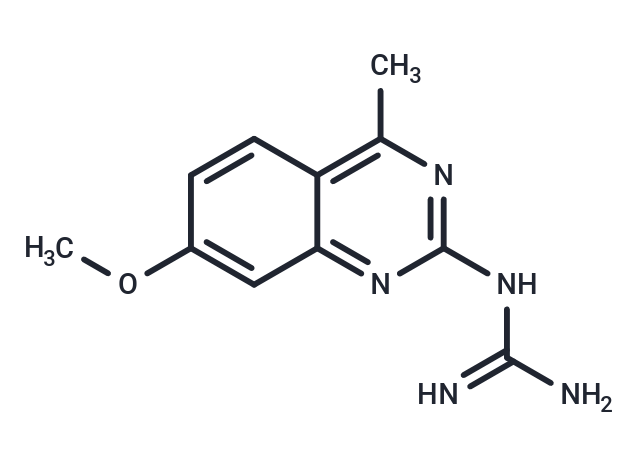Shopping Cart
- Remove All
 Your shopping cart is currently empty
Your shopping cart is currently empty

MPO-IN-28 is a novel potent, irreversible Myeloperoxidase (MPO) inhibitor with IC50 of 44 nM.

| Pack Size | Price | Availability | Quantity |
|---|---|---|---|
| 2 mg | $30 | In Stock | |
| 5 mg | $43 | In Stock | |
| 10 mg | $73 | In Stock | |
| 25 mg | $119 | In Stock | |
| 50 mg | $178 | In Stock | |
| 100 mg | $272 | In Stock | |
| 200 mg | $393 | In Stock | |
| 1 mL x 10 mM (in DMSO) | $97 | In Stock |
| Description | MPO-IN-28 is a novel potent, irreversible Myeloperoxidase (MPO) inhibitor with IC50 of 44 nM. |
| Targets&IC50 | MPO:44 nM (cell free) |
| In vitro | 5 μM of MPO-IN-28 was added to MPO in the presence of 30 μM of guaiacol. In the absence of H2O2, there was no inhibition of MPO, clearly underlining that MPO-IN-28 is an irreversible mechanism-based inhibitor. MPO-IN-28 inhibits the growth of normal human dermal fibroblast (NHDF) at a concentration (IC50) of 17 μM, which is about 400 times higher than the concentration of the MPO inhibitory effect (0.044 μM). |
| Kinase Assay | The assay is based on the production of taurine chloramine produced by the MPO/H2O2/Cl? system in the presence of a selected inhibitor at defined concentration. The reaction mixture contained the following reagents in a final volume of 200 μL: 10 mM phosphate buffer (pH 7.4, 300 mM NaCl), 15 mM taurine, compound to be tested (up to 20 μM), and a fixed amount of recombinant MPO (6.6 μL of MPO batch solution diluted 2.5 times, 40 nM). When necessary, the volume was adjusted with water. This mixture was incubated at 37 °C, and the reaction was initiated with 10.0 μL of H2O2 (100 μM). After 5 min, the reaction was stopped by the addition of 10 μL of catalase (8 units/μL). To determine the amount of taurine chloramine produced, 50 μL of 1.35 mM solution of thionitrobenzoic acid was added and the volume was adjusted to 300 μL with water. Then the absorbance of the solutions was measured at 412 nm with a microplate reader, and the curve of absorbance as a function of inhibitor concentration was plotted. IC50 values were then determined by standard procedures by taking into account the absence of hydrogen peroxide as 100% inhibition and the absence of inhibitors as 0% inhibition. |
| Cell Research | To evaluate whether selected compounds exhibited toxicity at the cellular level at concentrations ranging from 0.005 to 50 μM, the colorimetric assay MTT was performed58 in normal human dermal fibroblasts (NHDF). Briefly, cell line was cultured in cell culture flasks, grown, and maintained at 37 °C, 95% humidity, 5% CO2 in fibroblast medium FBM supplemented with 2% fetal bovine serum, 0.1% insulin, rhFGF-B, and gentamicin and amphotericin. NHDF cells were chemically detached with trypsin and seeded in 96-well plates and left to attach for 24 h. Prior to treatment, compounds were dissolved in DMSO at a concentration of 10 mM, and cells were treated with the different concentrations of the compounds diluted in culture medium (5 nM to 50 μM) or left untreated for 72 h. The amount of viable cells was determined through the MTT mitochondrial reduction into formazan by living cells according to previously described.58 The optical density (OD) was measured in a Biorad 680RX plate reader at 570 nm (reference 630 nm), and the OD of the untreated control was normalized as 100% of viable cells, allowing determination of the concentration that inhibited their growth by 50% (IC50). |
| Molecular Weight | 231.25 |
| Formula | C11H13N5O |
| Cas No. | 37836-90-1 |
| Smiles | COc1ccc2c(C)nc(NC(N)=N)nc2c1 |
| Relative Density. | 1.40 g/cm3 (Predicted) |
| Storage | Powder: -20°C for 3 years | In solvent: -80°C for 1 year | Shipping with blue ice. | ||||||||||||||||||||||||||||||
| Solubility Information | DMSO: 22.73 mg/mL (98.29 mM), Sonication is recommended. | ||||||||||||||||||||||||||||||
Solution Preparation Table | |||||||||||||||||||||||||||||||
DMSO
| |||||||||||||||||||||||||||||||

Copyright © 2015-2025 TargetMol Chemicals Inc. All Rights Reserved.